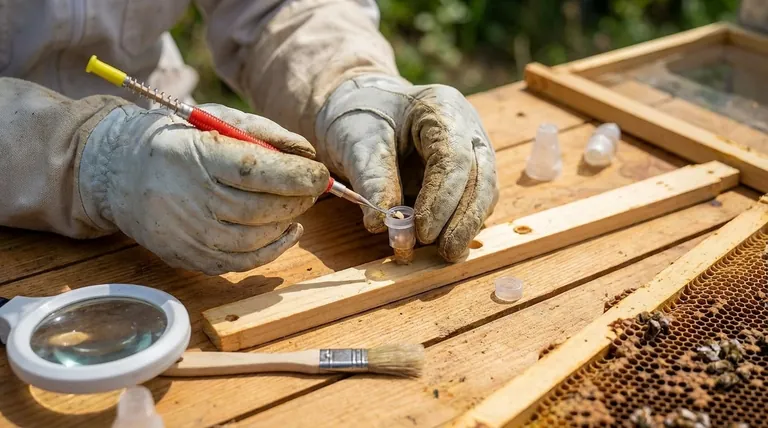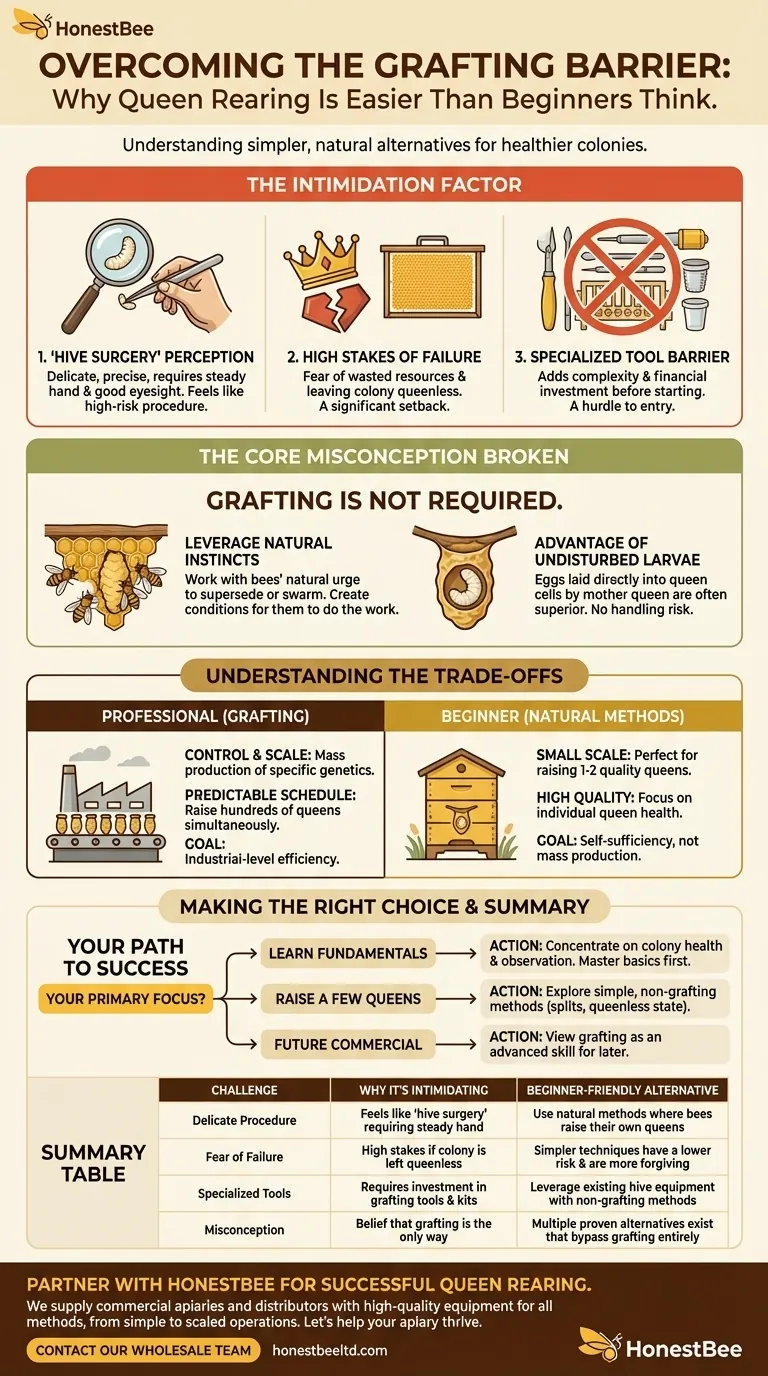For many new beekeepers, the idea of raising their own queens is both exciting and deeply intimidating. The primary disincentive is grafting, a technique widely perceived as a complex, delicate procedure requiring specialized skills and steady hands, making the entire prospect of queen rearing seem out of reach.
The core issue isn't the difficulty of grafting itself, but the misconception that it's the only way. Understanding that superior queens can be raised using simpler methods empowers beginners to improve their colonies without facing this daunting barrier.

What Makes Grafting So Intimidating?
Grafting involves manually transferring a day-old larva from a worker cell into an artificial queen cup. For a beginner, this process is fraught with perceived risk and complexity.
The Perception of 'Hive Surgery'
The task demands excellent eyesight, a steady hand, and precise movements. Moving a larva, which is barely visible to the naked eye, without causing damage can feel less like beekeeping and more like performing delicate surgery.
The High Stakes of Failure
A beginner's primary goal is to keep their colony alive and healthy. A failed grafting attempt feels like a significant setback, wasting time and resources, and potentially leaving a colony queenless if managed improperly.
The Barrier of Specialized Tools
Successful grafting requires specific equipment: grafting tools, cell bars, and cup kits. This adds another layer of complexity and financial investment before one can even begin, creating a barrier to entry.
The Core Misconception: Grafting is Not Required
The belief that grafting is essential for queen rearing is the single biggest hurdle. In reality, beekeepers can work with the bees' natural instincts to produce excellent queens through far simpler means.
Leveraging Natural Instincts
Bees naturally create queen cells to replace a failing queen (supersedure) or to swarm. Effective queen rearing for a beginner is simply about creating the right conditions to encourage this behavior in a controlled way.
The Advantage of Undisturbed Larvae
A key insight is that queens produced from eggs laid directly into a queen cell by the mother queen are often superior. The larva is never handled, exposed to the open air, or risked being damaged, receiving ideal care from the moment it hatches.
Simpler, Proven Alternatives
Methods exist that completely bypass the need for grafting. Techniques that involve splitting a colony or creating a temporary queenless state will prompt the bees to raise their own "emergency" queens from existing eggs, which is a far more natural and forgiving process.
Understanding the Trade-offs
While simpler methods are ideal for beginners, it's important to understand why professionals often rely on grafting. The choice is about scale and specific goals, not about one method being universally "better."
Why Professionals Graft
Grafting provides control and scale. It allows a commercial beekeeper to raise hundreds of queens of a specific age, from a single mother with desirable genetics, all on a predictable schedule. It is a tool for mass production.
The Beginner's Advantage
A beginner does not need fifty queens; they typically need one or two. Non-grafting methods are perfectly suited for this small scale. The goal is producing a few high-quality queens, not achieving industrial-level efficiency.
Making the Right Choice for Your Apiary
Your approach to queen rearing should match your current skill level and goals. Don't let an advanced technique discourage you from taking a valuable step in your beekeeping journey.
- If your primary focus is learning hive fundamentals: Concentrate on colony health and observation. Raising your own queens is a skill you can develop after mastering the basics.
- If your primary focus is raising a few high-quality queens for your own use: Explore simple, non-grafting methods that encourage the bees to do the delicate work for you.
- If your primary focus is future commercial-scale production: View grafting as an advanced skill to learn later, once you are confident and your needs demand that level of control and scale.
By working with your bees' natural instincts, you can successfully raise excellent queens and become a more self-sufficient beekeeper.
Summary Table:
| Challenge | Why It's Intimidating | Beginner-Friendly Alternative |
|---|---|---|
| Delicate Procedure | Feels like 'hive surgery' requiring a steady hand | Use natural methods where bees raise their own queens |
| Fear of Failure | High stakes if the colony is left queenless | Simpler techniques have a lower risk and are more forgiving |
| Specialized Tools | Requires investment in grafting tools and kits | Leverage existing hive equipment with non-grafting methods |
| Misconception | Belief that grafting is the only way to rear queens | Multiple proven alternatives exist that bypass grafting entirely |
Ready to confidently raise your own queens without the stress of grafting?
At HONESTBEE, we supply commercial apiaries and beekeeping equipment distributors with the high-quality supplies needed for successful queen rearing and colony management. Whether you're starting with simpler methods or scaling up your operation, we have the equipment and expertise to support your goals.
Let's discuss how we can help your apiary thrive. Contact our wholesale team today to get the right tools for your beekeeping journey.
Visual Guide

Related Products
- Retractable Chinese Queen Rearing Grafting Tools Equipment
- Brown Nicot Queen Cell Cups for Breeding Queen Bees Beekeeping
- Stainless Steel Scraper for Metal Queen Bee Excluders
- Wooden Queen Bee Excluder for Beekeeping
- Electric Flatting and Embossing Machine with Tray for Beekeeping
People Also Ask
- What is the purpose of grafting in queen bee production? Scale Your Apiary with Superior Genetics
- What is the primary method beekeepers use to produce multiple queen honey bees in a season? Master Grafting for Superior Genetics
- What is the process of grafting larvae? Master the Art of Queen Rearing for Your Apiary
- What are the steps involved in the grafting process? Master Queen Rearing for Your Apiary
- What characteristics make larvae suitable for grafting? Select the Perfect Larva for Queen Rearing



















